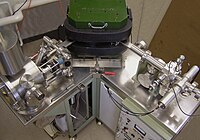
Photo from wikipedia
The position‐specific 15N isotope content in organic molecules, at natural abundance, is for the first time determined by using a quantitative methodology based on 15N Nuclear Magnetic Resonance (NMR) spectrometry.… Click to show full abstract
The position‐specific 15N isotope content in organic molecules, at natural abundance, is for the first time determined by using a quantitative methodology based on 15N Nuclear Magnetic Resonance (NMR) spectrometry. 15N NMR spectra are obtained by using an adiabatic “Full‐Spectrum” INEPT sequence in order to make possible 15N NMR experiments with a high signal‐to‐noise ratio (>500), to reach a precision with a standard deviation below 1‰ (0.1%). This level of precision is required for observing small changes in 15N content associated to 15N isotope effects. As an illustration, the measurement of an isotopic enrichment factor ε for each 15N isotopomer is presented for 1‐methylimidazole induced during a separation process on a silica column. The precision expressed as the long‐term repeatability of the methodology is good enough to evaluate small changes in the 15N isotope contents for a given isotopomer. As observed for 13C, inverse and normal 15N isotope effects occur concomitantly, giving access to new information on the origin of the 15N isotope effects, not detectable by other techniques such as isotope ratio measured by Mass Spectrometry for which bulk (average) values are obtained.
Journal Title: Magnetic Resonance in Chemistry
Year Published: 2019
Link to full text (if available)
Share on Social Media: Sign Up to like & get
recommendations!